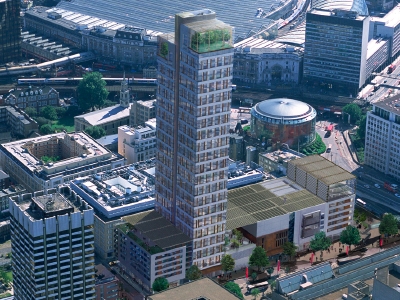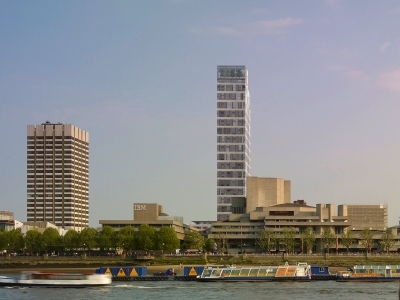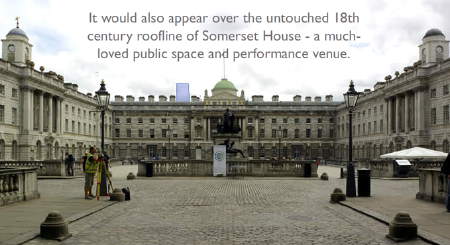Doon Street: "irreversible harm" to London or "much-needed facilities"?
The public inquiry into Coin Street Community Builders' controversial plans for a 43-storey tower and leisure centre on the South Bank opened at Lambeth Town Hall on Tuesday morning.




Coin Street Community Builders – which has made its name by building 220 homes on the South Bank for people in housing need – is now proposing 329 homes for market sale in a 144-metre tower.
The sale of these homes would fund a long sought-after public leisure centre and swimming pool for local residents and workers.
Lambeth Council resolved to grant planning permission last August but the scheme has sparked controversy for its impact on views from St James' Park and Somerset House and for the lack of any affordable housing in the proposals.
English Heritage successfully persuaded communities secretary Hazel Blears to "call in" the proposals for a public inquiry which began at Lambeth Town Hall on Tuesday.
The inquiry is being heard by planning inspector Philip Wilson who also heard the inquiries into the Founder's Place scheme and the Shell Centre podium development in North Lambeth.
The inquiry will sit for at least eight days and will hear from 14 witnesses for the main parties to the inquiry: Coin Street Community Builders, Lambeth Council, the Greater London Authority, English Heritage, Westminster City Council and the Royal Parks Agency.
The inspector will also hear from the Waterloo Community Development Group and a number of individual local residents as well as South Bank Employers' Group and the local Sport Action Zone.
"Our proposals seek to secure and sustain much-needed community facilities and programmes on a long term basis utilising social enterprise principles and an architectural and urban design solution of the highest quality," says CSCB director Iain Tuckett.
"They continue the process of changing the South Bank from the bleak hostile area it was in the 1970s to a thriving, diverse, mixed use neighbourhood which offers hope for London's future."
English Heritage says that the tower would seriously damage cross-London views as well as the setting of listed buildings and conservation areas nearby, arguing that other design options could have delivered the same public benefit without damaging the London skyline.
"This development will seriously harm two of London's most treasured views; the world-famous view of Whitehall from the bridge in St James's Park and the sublime symmetry of the courtyard of Somerset House when viewed from its entrance," says Philip Davies of English Heritage.
"English Heritage is certainly not calling for an embargo on new development along the South Bank but CSCB appear to have chosen to put a very tall building on this site for its own sake, regardless of the harm it will cause to the skyline of London. Londoners – and the millions of people who visit our capital each year – deserve better."
CSCB's opening remarks
"We believe it's clearly the right solution to achieve the requirements of the site and area," William Hicks QC told the inquiry.
He went on to outline why alternative designs – such as a single low-rise building or two shorter towers – had been rejected.
Hicks explained that a single slender tower of high-quality design would "play a positive role in a line of punctuating towers" on the South Bank.
"It is unlikely that the objectives for the site could be achieved without a tower that was visible from St James's Park and the upper terrace of the courtyard of Somerset House."
English Heritage
Neil King QC – for English Heritage – warned that the development would cause "very significant and irrevocable harm to nationally-important heritage sites".
"English Heritage readily accepts that change ... is to be welcomed provided that the historic environment ... is not materially damaged," he said, adding that his client welcomed developments which "complement and enhance" England's heritage.
He noted that English Heritage considers Lifschutz Davidson Sandilands' design for Doon Street to be of "good if not necessarily exceptional architectural quality".
He went on to suggest that CSCB had not demonstrated that the benefits of the scheme "could not be achieved by a development that had less impact on the historic environment.
Westminster City Council
Peter Harrison QC, on behalf of the City of Westminster, suggested that the benefits of the development argued by CSCB were primarily local to Waterloo whilst the impact on views will be London-wide.
Royal Parks Agency
The Royal Parks Agency's solicitor Brian Greenwood told the inquiry that his client "objects most strongly" to the "obtrusive and destructive" tower.
He added that "one could not locate a tower on the South Bank in a worse possible position as far as the Royal Parks are concerned," going on to argue that the developer had failed to demonstrate benefits sufficient to outweigh the "damage" that the tower would cuase.
Evidence of Coin Street boss Iain Tuckett
Tuckett told the inquiry that in his view the tower would be "an attractive and beneficial addition both to the London skyline and to the South Bank" that would provide a much-needed leisure facility "at an affordable price", as well as bringing new employment opportunities for local people.
"The public benefit is of an unprecedented scale in my experience," he said.
Iain Tuckett was questioned as to the viability of the proposed scheme.
He conceded that the current 'soft funding' requirement of £23 million is unlikely to be met.
"[The scheme] certainly would not proceed unless the figures improve," he said.
The tower part of the scheme could not be built, he said, "unless values increase faster than costs".
"That does not mean that none of the elements of the Doon Street proposal will proceed," he added, explaining that the western educational building – which could be occupied by King's College London – nearest Waterloo Bridge and the related public square could be built independently of the rest of the development on the site.
"If the application was refused, we would have to concede that achieving a public swimming pool is not possible."
In his written evidence Tuckett also raises the possibility that CSCB could sell part of the site if planning permission is not granted.
Future of the Colombo Centre
Cross-examined by Michael Ball of the Waterloo Community Development Group, Tuckett said that if the Doon Street leisure centre goes ahead, "I don't think that the Colombo Centre will carry on being used in the way that it is."
• English Heritage has published a slideshow at www.english-heritage.org.uk/doonsttower
Comments
Share
The SE1 website is supported by people like you
More to read
- Channel 4 to make reality TV show in South Bank Tower penthouse 9 Nov 2022
- Lambeth paves the way for skyscraper on Waterloo IMAX site 8 Oct 2018
- Artist and activist Veronica Planton remembered at Waterloo exhibition 6 Jul 2014
- Queen opens Rambert dance company HQ on the South Bank 21 Mar 2014
- SE1 joins 'prime' central London property market 15 Oct 2013
- South Bank Tower: council approves 5 extra floors and collects £5m 17 Jul 2013
- Shell Centre redevelopment approved: nearly 900 South Bank homes 22 May 2013
- Rambert's dancers get preview of new South Bank headquarters 21 May 2013
- Lambeth kids visit Rambert Dance Company's new South Bank home 6 Mar 2013
- MBE for Coin Street boss Iain Tuckett in New Year honours list 29 Dec 2012
Related forum discussions
- "Mama Mia: The Party" coming to Coin Street?
- Elephant and Castle Leisure Centre Project Consultation
- Blackfriars Road skyscrapers
- Mayoral Election.
- Coin Street's revised plans for a tower of only 43 storeys - still a betrayal of their founding principles?
- New development on Recall site
- London Park Hotel Site
- Swimming lessons for young children
Follow us
Email newsletter
For the latest local news and events direct to your inbox every Monday, you need our weekly email newsletter SE1 Direct.

